MG Abingdon – New Horizons Part 2

 The MGB, Abingdon’s replacement for the MGA, was introduced at the Earls Court Motor Show in October 1962. This was not before at least two major design changes had been made by Syd Enever and his team.
The MGB, Abingdon’s replacement for the MGA, was introduced at the Earls Court Motor Show in October 1962. This was not before at least two major design changes had been made by Syd Enever and his team.
The first involved replacing the proposed new and more complex, rear suspension system with the more predictable, and well proven, semi-elliptical leaf springs. There were several reasons for this change of heart. Firstly, there was the question of whether the new design would give sufficient improvement to the car’s handling to justify its adoption. Trials with a similar set-up on an MGA had shown it to be endowed with a certain liveliness that was not always predictable. Then there was the question of the intrusion into the boot space of the turrets required for the coil spring and shock absorber units and finally the extra on costs associated with going down this particular route. The view was that if a better and cost effective system could be developed, it could always be introduced at a later stage in the car’s life.
The other major change was to the front end styling. Syd had always favoured a rounded front end inspired by the nose of the EX1 81 record car. However, during a visit to the Geneva Motor Show his eye was caught by the newly introduced Renault ‘Floride’, the tourer version of which was of similar proportions to the ‘B’. Syd was particularly impressed by the front end treatment although of course being rear-engined it didn’t feature any kind of grille. Back in Abingdon he instructed his model-maker, Harry Herring, to slice off the front of the quarter scale model between the headlamp wells and immediately achieved a similar appearance. lt was then a relatively simple matter to add a grille and hey presto! the classic MGB as we know it today, was born.
With its ‘B’ series engine now increased in size to 1798cc, the MGB was not the only new model to be found on the MG stand in 1962. Vying for attention was the all new MG1100, the first of the ADO16 range of medium sized, transverse-engined family saloons that would become BMC’s best sellers. The MG 1100 featured a brand new type of suspension designed by Alex Moulton and masterminded by Alex lssigonis, given the descriptive title of Hydrolastic. This was an inter-linked, fluid based arrangement that acted as both a springing and damping system, which brought a new dimension to vehicle suspensions and probably justified BMC’s sales pitch at the time, describing the MG 1100 as ‘the most advanced MG of all time’. Completing the MG line-up were the MG Magnette Mk lV and the MG Midget. The Midget now featured the 1100 (1098cc), A-Series engine, front disc brakes and revised interior trim. This was the first time in a very long while that MG offered a choice of four completely different styles of motor car.

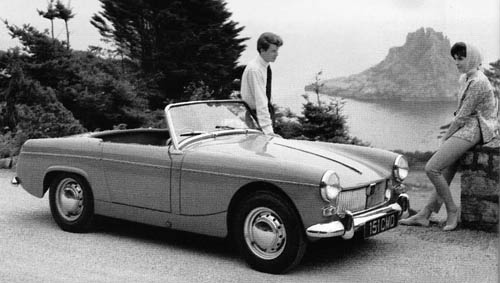
ln 1963, their first full year of manufacture, the MG 1100 actually outsold the MGB by a margin of some 3,000 units. However, Abingdon produced a healthy 40,000 two-seaters (not including big Healeys) and were well satisfied with their efforts. The ‘B’ had proved to be a worthy successor to the MGA and had been well received in all markets, both at home and overseas.
Although the curtain had fallen on any future record breaking and a ban enforced as far as any official involvement in motor racing was concerned, there was still plenty of motor sporting activity emanating from the Abingdon factory. As early as 1955 John Thornley had worked with the main board to set up the BMC Competitions Department in order to demonstrate to the world that their cars could compete successfully in the most demanding events in the international calendar. Located at Abingdon and headed up by Marcus Chambers, the department would prepare selected examples of both saloon and sports cars to be entered in mainly continental rallies. To begin with they shared both workshop facilities and mechanics with the Development department, but it soon became obvious that ‘Comps’ would require a home of their own. After a bit of shuffling round (space was always at a premium at Abingdon), they were allocated part of a unit at the opposite end of ‘B’ block.
lt was no easy task to break into the European rally scene but Marcus gradually built up a strong team of drivers. He was among the first to recognise the added publicity value of having lady drivers in his team. He quickly signed up Nancy Mitchell, an already experienced rally driver, and also Pat Moss, sister of Stirling, who, what she lacked in experience, more than made up in sheer undiluted enthusiasm! A variety of cars were tried and by the end of the 1950s, the car that began to emerge as one of the best was, somewhat unexpectedly, the Austin Healey 3000, or ‘big Healey’ as it became affectionately known. By 1960 the pairing of Pat Moss and Ann Wisdom came 2nd overall and won the Ladies Prize in the Alpine Rally in a Healey 3000 and in the very next rally, the Liege-Rome-Liege, achieved an outright win as well as the Ladies Prize, in the very same car.
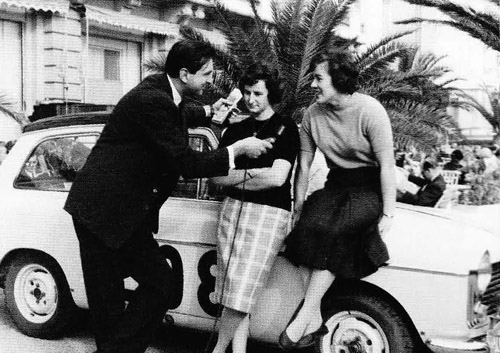
By 1961, Marcus Chambers decided to leave the hectic lifestyle of international rallying behind to spend more time at home and handed the reins over to the young and as yet untested Stuart Turner. Thornley needn’t have worried as Stuart would prove to be every bit as talented as his predecessor and would become known as the man who put the ubiquitous ‘Mini’ on the map as a successful rally car.
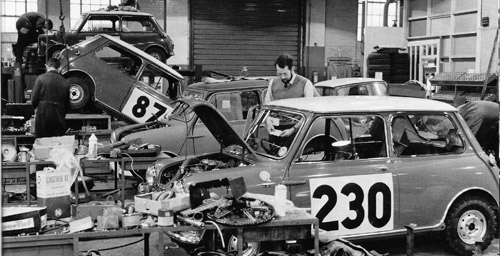
The introduction of the Triumph Spitfire in October 1962 put BMC into a bit of a tailspin. Triumph’s attractive Michelotti designed equivalent to the Spridget, whilst in no way technically superior, did offer such home comforts as wind up windows in the doors from day one. As a result Abingdon were instructed to begin work to update the Sprite and Midget on an urgent basis. Ln the Spring of 1964, therefore, the Sprite Mk lll and Midget Mk ll made their introduction sporting a new windscreen and wind up windows with front quarter lights. The opportunity was also taken to introduce semi elliptic rear springs in place of the old quarter elliptics and make certain engine improvements.
Since the introduction of the MGB, the Abingdon Design office had been working on a fixed head, GT version of the car, so far with limited success. The limiting factor was identified as the low windscreen, fine for an open sports car but it didn’t lend itself to a coupe. As the production drawing office was up to its neck as usual, Jim Stimson from the Project Office (that had been working on Roy Brocklehurst’s hydrolastic EX234) was asked by Jim O’Neill to generate some new roof lines based on a completely new windscreen. At this time Pinin Farina were doing quite a bit of work for BMC and Syd Enever was instructed to send these new lines over to Italy for further development. When the finished prototype returned from Farina everybody liked it so much that George Harriman instructed Pressed Steel and MGto tool it up for production with no further changes. The only work that Abingdon were required to do revolved around the tailgate hinges and spring assists, and new interior trim. Announced in October 1965, the MGB GT was an instant success and added a valuable extension to the MG range.
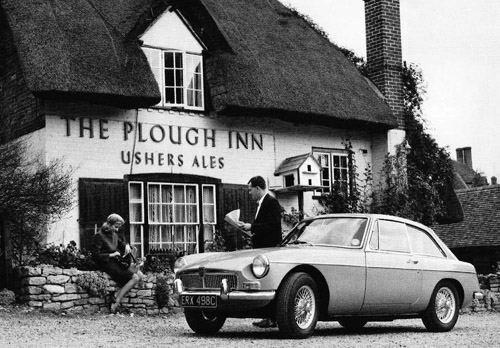
1965 had also seen the acquisition of the Pressed Steel Company at Oxford and Swindon by BMC in an attempt to safeguard the future manufacture and supply of bodies to the Corporation. Although this was a sensible move it did impose quite a strain on the company’s finances. Fisher & Ludlow, the other major body pressing company that mainly supplied Longbridge, had already been taken over by BMC soon after its formation in the early 1950s.
At the 1966 Motor Show the Midget (and Sprite) emerged with a brand new folding hood (featuring three bows similar to the MGB to give it a better shape). ln order to accommodate this, the metalwork around the rear tonneau panel had to be reshaped to allow the hood to sit neatly inside the cockpit when folded down. The engine had also been uprated to bring it into line with the 1275 Mini Cooper specification. ln fact 1966 saw Abingdon somehow squeeze yet another new production line (their seventh) into ‘A’ building to cope with increasing demand.
1966 also sprung something of an unexpected surprise. As the result of financial difficulties the Coventry firm of Jaguar Daimler now found itself part of what had now been renamed British Motor Holdings. As Jaguar operated at the high end of the sports car market, MG did not perceive them to be any kind of threat to their future activities. ln fact being kindred spirits in the American market they would be more of a help than a hindrance. What did irritate people at Abingdon slightly was that they had been renamed simply ‘MG Division’.
Finally after a great deal of huffing and puffing by the BMC management, the long awaited MGC was unveiled at the 1967 Motor Show. Initially intended to run in tandem with a new Austin Healey, the ‘C’ was now seen as a replacement for the big Healey. Sporting a brand new 2912cc 6 cylinder engine giving 145bhp @ 5250rpm, it was given a less than enthusiastic welcome by the motoring press. After so long a wait they were, frankly, expecting something rather more exciting from the Abingdon stable. Once they began road testing the car things just went from bad to worse! The new 7 bearing engine was probably the biggest disappointment. Although a complete redesign of the 2.9 litre unit as used in the Healey 3000, its maximum quoted horsepower was 5bhp down on that of the old engine. Added into the mix were criticisms such as poor low speed torque, heavy steering and pronounced understeer. Further bad press was generated by the fact that its outward appearance, in spite of a distinctive bulge on the bonnet and larger wheels, had little to set it apart from the MGB. Unfortunately, almost all the available budget had needed to be spent on the changes to the underbody structure to enable it to accept the larger engine and new front suspension: costs that had tended to escalate as time had gone on. It’s always easy to be wise after the event but perhaps if the car had been given better seats, improved trim and maybe a new instrument panel and alloy wheels, attention would have been drawn away from its shortcomings. We will never know. What we do know however is that today these cars are highly prized by their current owners. After just two years in production the MGC quietly disappeared from the MG line up.

The MG factory bore witness to a rather poignant event in 1967: the retirement presentation of their longest serving employee, Cecil Cousins. He had begun his career with The Morris Garages in 1920 as a mechanic after having served an apprenticeship with a small Oxford engineering company. He was soon to be chosen by Cecil Kimber to run the small workshop in Alfred Lane modifying Morris cars to give them a more sporting appeal. From that point on he was to stay with the company for the rest of his working life, eventually rising to the position of works manager. Whilst he had a high regard for the early days of MG, he was not one to wallow in nostalgia. When asked which MG he considered the best he would always answer, ‘the next one off the line’.
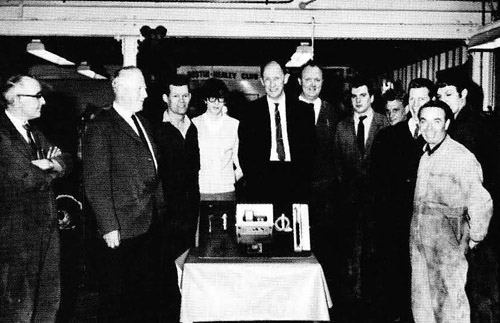
January 1, 1968 was the deadline for compliance with both the Federal Vehicle Safety Legislation and the Emissions Act, which the US President Lyndon B. Johnson had already signed into law. Whilst this was primarily aimed at American cars, it would have a serious impact on importers in general and Abingdon in particular. From now on most of the design work undertaken by Syd Enever’s department would be concerned with simply keeping abreast of the ever increasing pile of regulations.
In the Spring of 1968 the Magnette Mk IV was finally phased out after cementing its place firmly in the long line up of MG models.
This event was completely overshadowed, however, by the announcement that British Motor Holdings had agreed a merger with the Leyland Group. Engineered by the then Labour government, this coming together had exploited BMH’s weak financial position. After a brief boardroom skirmish, Donald Stokes, the Leyland MD, emerged as the Chairman of the newly formed British Leyland Motor Corporation. This new grouping, of course, brought the Triumph range of cars into the company and Abingdon immediately sensed that there would be trouble ahead…
Our thanks once again to Andy Knott, Editor Safety Fast, and author, Peter Neal, for their permission to reprint this article.


